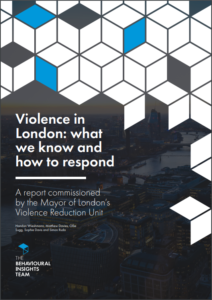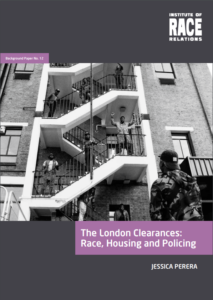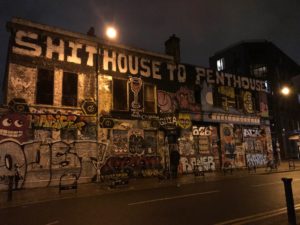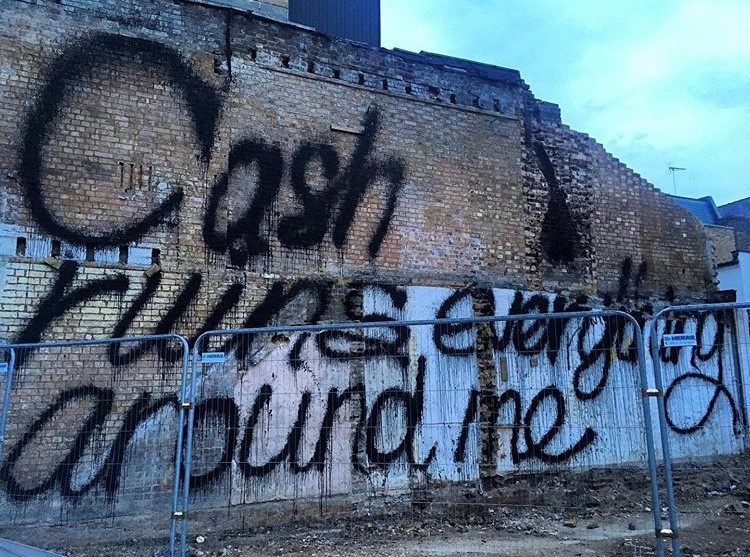How can the Mayor of London’s approach to knife crime work, when the structural causes of knife crime are not being fully addressed? A review of recent government and GLA initiatives.
The number of knife and gang-related homicides in London has surged since 2014. And young black men are overrepresented as victims and perpetrators of serious youth violence. To combat violent crime in London, the Mayor of London recently announced that the ‘police precept’ element in council tax will be significantly raised in order to properly resource the Metropolitan Police, fast-track the recruitment of 600 more police officers and plug the gaps caused by the Conservative government’s disinvestment in policing and youth provision. The irony is that while central government continues its austerity agenda – stripping funds from threadbare social infrastructure that is needed to reduce youth violence – ordinary Londoners will end up paying more, not to address the structural causes of knife crime, but to police their own desperate young people.
What does a public health approach mean?

London’s ‘surplus population’ of marginalised and unemployed young people are scratching out a living in the cracks and crevices of what remains of the working-class multicultural city. For many of the ‘newcomers’ in London’s gentrified enclaves, as well as the local authorities implementing regeneration, these young people can come to be seen as this century’s ‘dangerous class’ [1] – blighting the city with an epidemic of violence. Interestingly, the government’s vaunted new ‘public health approach’ (PHA) to knife crime, which it has been following since April 2019, has a historical legacy that can be traced back to the Victorian era, where views ‘of the city in which disorder might spread or be contagious; where the poor and the criminal might threaten to engulf the whole city’ was couched in a similar epidemiological lexicon we see today. [2] The threat of crime and disorder as contagious is politically functional, allowing for Conservative doublespeak. While the Home Office presents the PHA as a break with law and order hard-nosed policing, at the same time, it is easing stop and search restrictions on urban police forces in overwhelming black populated areas.
 According to former Conservative Home Secretary, Sajid Javid, serious youth violence ought to be viewed and treated like a ‘disease’, necessitating a concerted, legalised, public sector effort – known as a ‘public health duty’. It is worth noting that in an earlier iteration the duty would have, fundamentally, turned teachers, NHS staff, youth workers and others, into a police force (by stealth) obliged to profile those in their care. However, after widespread outrage by teachers’ unions, the duty was revised, and in summer 2019 (following a brief consultation) it was enacted in law. What remains is a requirement for organisations, as opposed to individuals, to work collaboratively by sharing data, intelligence and knowledge with the aim of understanding and addressing ‘the root causes’ of knife crime and targeting interventions. [3]
According to former Conservative Home Secretary, Sajid Javid, serious youth violence ought to be viewed and treated like a ‘disease’, necessitating a concerted, legalised, public sector effort – known as a ‘public health duty’. It is worth noting that in an earlier iteration the duty would have, fundamentally, turned teachers, NHS staff, youth workers and others, into a police force (by stealth) obliged to profile those in their care. However, after widespread outrage by teachers’ unions, the duty was revised, and in summer 2019 (following a brief consultation) it was enacted in law. What remains is a requirement for organisations, as opposed to individuals, to work collaboratively by sharing data, intelligence and knowledge with the aim of understanding and addressing ‘the root causes’ of knife crime and targeting interventions. [3]
Framing knife crime as an epidemic not only sensationalises the issue, it also forecloses on any meaningful inquiry into the systemic origins of youth violence. But knife crime, as I have argued before, has not appeared out of thin air, it is the ‘violence of the violated’ – born out of deprivation, desperation and defilement. And palliative multi-agency solutions, like the public health approach (including the profiling duty described above), only obfuscate the way that the government’s enduring austerity agenda has left a generation of young people bereft of support. This becomes even more problematic in a situation where ethnic minorities are overrepresented as victims and perpetrators. For this then lends justification to the police’s use of racial profiling. Considering the PHA seeks, among other things,[4] to ‘focus on defin(ing) a population, often with a health risk in common’, one might not be blamed for seeing this as dog-whistle politics that will stigmatise young working-class ethnic minorities as ‘contagions’, and sanction heavier policing against black people.
Moreover, as James Rosbrook-Thompson has argued, there is reason to seriously question whether and to what extent, there has been an attempt to manufacture consent for the PHA, given its compatibility with pre-existing government regime: neoliberalism.[5] Drawing on interviews he conducted among those enforcing the approach in London,[6] Rosbrook-Thompson found many public sector workers were dubious about both the methods and potential success of the PHA, commenting on the expediency of collaborative working, data sharing and targets that allow under-resourced services to (just about) function according to the logic of austerity. This interlocking of services, while appearing more ‘efficient’, highlights the transformation of the public sector from one that succours to one that surveils. The preoccupation with profiling a dangerous class manages to completely depoliticise the issue. As one exasperated youth worker in Rosbrook-Thompson’s study exclaimed, the PHA is not ‘getting down to the root causes of the issues’, ‘look how far the gap is between the rich and the poor in this [London] borough’. Here the participant alludes to socio-spatial inequality in the city – an important point considering extensive regeneration projects are changing the profile of communities, a process which is entrenching race-class segregation and eroding community bonds. While there is emerging state interest in the spatial dimension to violence (see below), no attempt is made to politically analyse the effects of the housing crisis on the working classes.

The Mayor of London’s analysis of violence in London
In 2018, the Labour Mayor of London launched England’s first Violence Reduction Unit (VRU)[7], following the success of the pioneering Glasgow model. In January 2020, the VRU commissioned The Behavioural Insights Team (BIT) – the government’s former ‘nudge unit’ – to publish a report detailing a ‘strategic needs assessment’ that uses behavioural science techniques to analyse violence in London and ‘identify the current and future health needs of local populations to inform and guide the planning of services with a local authority area’. (Behavioural science which utilises empirical data, theories and hypotheses to investigate human decisions in society, purports to be a more exact science than say sociology and more pointed than say psychology.)
Building on earlier research conducted by the Mayor’s Office for Policing and Crime (MOPAC), which suggested there is a statistically significant relationship between borough-level deprivation and serious youth violence, the BIT report delivers one clear definitive message that ‘violence in London is highly geographically concentrated’ and occurs in ‘neighbourhoods that are also likely to have higher levels of deprivation’. ‘Given this’, it states, ‘it is essential that we understand the interaction between specific locations with broader demographic and attitudinal characteristics before concluding who might be at risk of violence (both as victims and perpetrators)’.
While BIT’s work might seem more rigorous, in terms of both analysis and strategy (in part because it is now an international organisation comprised of powerful technocrats with major political influence), it is at best limited, and at worst misleading. There is nothing new in the argument that violence and area-based deprivation are strongly correlated. What is new, however, and overlooked, is that housing-related poverty is worsening, and is particularly severe for children in inner London. Hence, the terms of the debate need to be widened to incorporate the deep-rooted problems that the housing crisis in its myriad forms is causing in London and the fear that poor housing generates in the working classes – especially London’s very large ethnic minority population, which has reduced opportunities to access inexpensive, adequate and stable accommodation. Yet BIT’s analysis is severely lacking in this respect, merely stating that high violence neighbourhoods suffer greater barriers to housing and services, worse living conditions (i.e. poorer housing quality)’, and have more transient populations, for example they are said to have a higher population turnover and lower proportion of owner occupiers. What we are not told is how this has happened, i.e. what ‘barriers’ have been put in place by successive governments. For example, do high violence neighbourhoods have more transient populations because of the abolition of secure and assured tenancies for new social housing occupants under the Housing and Planning Act 2016, which forces poorer people out of their homes and into transitory lifestyles?[8] BIT does not examine the various changes to housing policy over the decades. Instead, ‘community cohesion and social trust’ while listed as ‘important protective factors’ against violence, are discussed in a political vacuum. And yet, the rate at which community bonds have been eroded surely has increased exponentially (and in line with dispossessing and displacing regeneration projects) since this period.
Loss of multicultural communities
The fabric of society has frayed. Worn out young people, deprived in numerous, compounding ways and experiencing an actual loss of multicultural working-class ‘community’ has profound implications. It is no surprise then that gangs form in areas, according to BIT, ‘where there are higher levels of deprivation, higher proportions of migrant populations, lower house prices and lower average educational attainment’. Gangs are, in a sense, perverse communities when the social and economic apparatus needed to make normal communities are removed. The 2008 recession and subsequent reduction in employment opportunities for young people (especially those excluded from school and/or with no qualifications) are forcing this generation towards an informal living in the drugs and robbery markets. While BIT does draw connections between the recession, reductions in public spending, unemployment and the drugs market, it is interesting that emphasis is put on the increase in cocaine purity that is believed to be driving up working-class gang activity. (However, what of the increase demand from users of this party drug? Mayor of London Sadiq Khan has argued there is a clear link between cocaine consumption among the middle classes and rising violence in the capital.)
 Furthermore, BIT link the presence of gangs in some neighbourhoods to ‘features of the built environment’, including ‘cheap accommodation’, among other things. We should be cautious of such an argument, and where it might lead. As I argued in The London Clearances: Race, Housing and Policing, after the 2011 riots, council estates have been portrayed by the political class as ‘ghettos’ where marauding gangs of youths, malcontents and rioters live, sell drugs, thieve, riot and kill one another. The purpose of this ideological assault has been to foster public support for demolition and redevelopment of these sites, therefore eliminating the ‘threat’ people living in council housing pose to regeneration plans.
Furthermore, BIT link the presence of gangs in some neighbourhoods to ‘features of the built environment’, including ‘cheap accommodation’, among other things. We should be cautious of such an argument, and where it might lead. As I argued in The London Clearances: Race, Housing and Policing, after the 2011 riots, council estates have been portrayed by the political class as ‘ghettos’ where marauding gangs of youths, malcontents and rioters live, sell drugs, thieve, riot and kill one another. The purpose of this ideological assault has been to foster public support for demolition and redevelopment of these sites, therefore eliminating the ‘threat’ people living in council housing pose to regeneration plans.
The psychosocial trauma of gentrification
Violence in London, though worryingly high, is actually in proportion with the national average, however, London’s robbery rate is not. In fact, it has increased by 13 per cent since 2014, and the proportion of robberies and attempted murders involving a knife has increased by 5 per cent over the same period. We do not know the demographics of robbery victims and perpetrators, i.e. is it young, working-class people robbing from each other or from the affluent classes. But there is an argument to be made about the hidden psychosocial trauma gentrification induces in impoverished populations. For the affluent classes, which have the temerity to amble around the city, turning multicultural neighbourhoods into destinations for tourism gentrification their class can ‘own’, are oblivious that their financial security is a deeply othering experience for the incumbent population. They highlight the latter’s insecurity and desire for the trappings of luxury city life. Drill artist Headie One, on his song ‘Both’, captures the intense material anxiety experienced by impoverished young people, asserting ‘I was tryna get rich or die, fuck tryin’,’ I’d rather be dead than poor, I’m really out tryna govern it all, money power, respect and more’. These macabre lyrics tell us something important about life in London for young people, that death, however it occurs, is better than scratching out a living in a city that has no use for them.


